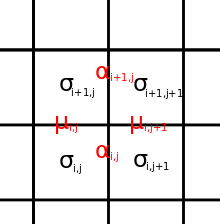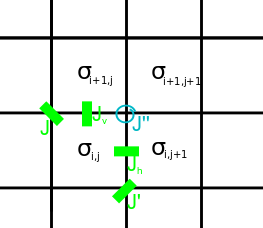Solution in the zero-field case
The zero-field case of the model corresponds physically to the absence of external electric fields. Hence, the model remains unchanged under the reversal of all arrows. The states 1 and 2, and 3 and 4, consequently must occur as pairs. The vertices may be assigned arbitrary weights

The solution is based on the observation that rows in transfer matrices commute, for a certain parametrization of these four Boltzmann weights. This came about as a modification of an alternate solution for the six-vertex model which makes use of elliptic theta functions.
Commuting transfer matrices
The proof relies on the fact that when  and
and  , for quantities
, for quantities

the transfer matrices  and
and  (associated with the weights
(associated with the weights  ,
,  ,
,  ,
,  and
and  ,
,  ,
,  ,
,  ) commute. Using the star-triangle relation, Baxter reformulated this condition as equivalent to a parametrization of the weights given as
) commute. Using the star-triangle relation, Baxter reformulated this condition as equivalent to a parametrization of the weights given as

for fixed modulus  and
and  and variable
and variable  . Here snh is the hyperbolic analogue of sn, given by
. Here snh is the hyperbolic analogue of sn, given by

and  and
and  are theta functions of modulus
are theta functions of modulus  . The associated transfer matrix
. The associated transfer matrix  thus is a function of
thus is a function of  alone; for all
alone; for all  ,
, 

Equivalence with an Ising model
There is a natural correspondence between the eight-vertex model, and the Ising model with 2-spin and 4-spin nearest neighbor interactions. The states of this model are spins  on faces of a square lattice. The analogue of 'edges' in the eight-vertex model are products of spins on adjacent faces:
on faces of a square lattice. The analogue of 'edges' in the eight-vertex model are products of spins on adjacent faces:


The most general form of the energy for this model is

where  ,
,  ,
,  ,
,  describe the horizontal, vertical and two diagonal 2-spin interactions, and
describe the horizontal, vertical and two diagonal 2-spin interactions, and  describes the 4-spin interaction between four faces at a vertex; the sum is over the whole lattice.
describes the 4-spin interaction between four faces at a vertex; the sum is over the whole lattice.

We denote horizontal and vertical spins (arrows on edges) in the eight-vertex model  ,
,  respectively, and define up and right as positive directions. The restriction on vertex states is that the product of four edges at a vertex is 1; this automatically holds for Ising "edges." Each
respectively, and define up and right as positive directions. The restriction on vertex states is that the product of four edges at a vertex is 1; this automatically holds for Ising "edges." Each  configuration then corresponds to a unique
configuration then corresponds to a unique  ,
,  configuration, whereas each
configuration, whereas each  ,
,  configuration gives two choices of
configuration gives two choices of  configurations.
configurations.
Equating general forms of Boltzmann weights for each vertex  , the following relations between the
, the following relations between the  and
and  ,
,  ,
,  ,
,  ,
,  define the correspondence between the lattice models:
define the correspondence between the lattice models:

It follows that in the zero-field case of the eight-vertex model, the horizontal and vertical interactions in the corresponding Ising model vanish.
These relations gives the equivalence  between the partition functions of the eight-vertex model, and the (2,4)-spin Ising model. Consequently a solution in either model would lead immediately to a solution in the other.
between the partition functions of the eight-vertex model, and the (2,4)-spin Ising model. Consequently a solution in either model would lead immediately to a solution in the other.
This page is based on this
Wikipedia article Text is available under the
CC BY-SA 4.0 license; additional terms may apply.
Images, videos and audio are available under their respective licenses.























































